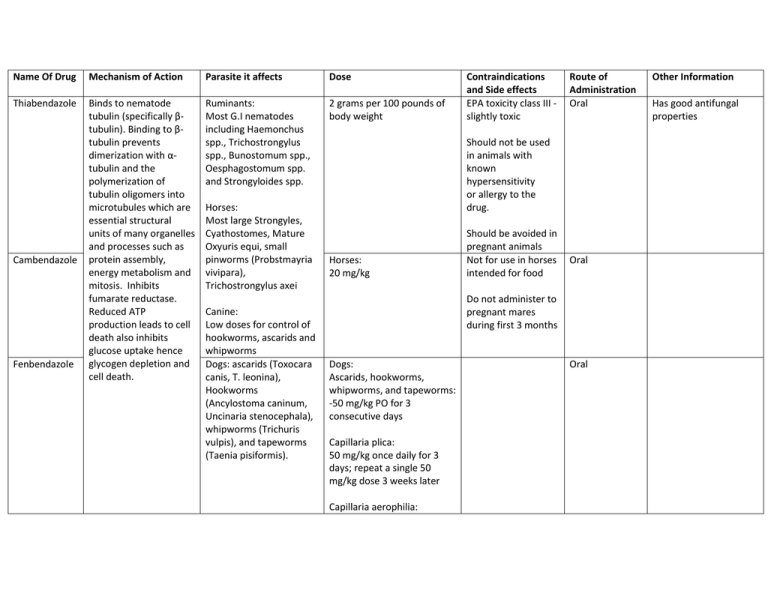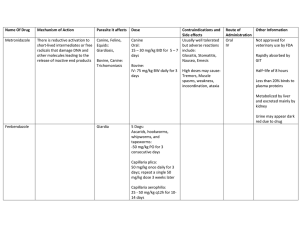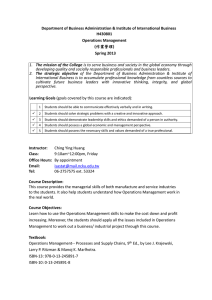Name Of Drug Mechanism of Action Parasite it affects Dose Contraindications
advertisement

Name Of Drug Mechanism of Action Parasite it affects Dose Thiabendazole Binds to nematode tubulin (specifically βtubulin). Binding to βtubulin prevents dimerization with αtubulin and the polymerization of tubulin oligomers into microtubules which are essential structural units of many organelles and processes such as protein assembly, energy metabolism and mitosis. Inhibits fumarate reductase. Reduced ATP production leads to cell death also inhibits glucose uptake hence glycogen depletion and cell death. Ruminants: Most G.I nematodes including Haemonchus spp., Trichostrongylus spp., Bunostomum spp., Oesphagostomum spp. and Strongyloides spp. 2 grams per 100 pounds of body weight Cambendazole Fenbendazole Horses: Most large Strongyles, Cyathostomes, Mature Oxyuris equi, small pinworms (Probstmayria vivipara), Trichostrongylus axei Canine: Low doses for control of hookworms, ascarids and whipworms Dogs: ascarids (Toxocara canis, T. leonina), Hookworms (Ancylostoma caninum, Uncinaria stenocephala), whipworms (Trichuris vulpis), and tapeworms (Taenia pisiformis). Contraindications and Side effects EPA toxicity class III slightly toxic Route of Administration Oral Should not be used in animals with known hypersensitivity or allergy to the drug. Horses: 20 mg/kg Should be avoided in pregnant animals Not for use in horses intended for food Oral Do not administer to pregnant mares during first 3 months Dogs: Ascarids, hookworms, whipworms, and tapeworms: -50 mg/kg PO for 3 consecutive days Capillaria plica: 50 mg/kg once daily for 3 days; repeat a single 50 mg/kg dose 3 weeks later Capillaria aerophilia: Oral Other Information Has good antifungal properties 25 - 50 mg/kg q12h for 10-14 days Filaroides hirthi: 50 mg/kg PO once daily for 14 days. Symptoms may worsen during therapy, presumably due to a reaction when the worm dies Taenia spp. Tapeworms: 50 mg/kg PO for 3 days. Paragonimus kellicoti: 50 - 100 mg/kg PO divided twice daily for 10-14 days Trichuris Colitis: Typhlitis: 50 mg/kg PO once daily for 3 consecutive days; repeat in 2-3 weeks and again in 2 months Crenosoma vulpis: 50 mg/kg PO once daily for 3 days Giardia: 50 mg/kg PO once daily for 3 days Eucoleus boehmi: 50 mg/kg PO once daily for 10-14 days; improvement may only be temporary Cats: Ascarids, hookworms, Strongyloides, and tapeworms: 50 mg/kg PO for 5 days. lungworms (Aelurostrongylus abstrusus): 20 mg/kg PO once daily for 5 days; repeat after 5 days. lungworms (Capillaria aerophilia): 50 mg/kg PO for 10 days. Capillaria feliscati: 25 mg/kg bid PO for 3-10 days. Paragonimus kellicoti: 50 mg/kg PO daily for 10 days. Cattle: Haemonchus contortus, Ostertagia ostertagi, Trichostrongylus axei, Bunostomum phlebotomum, Nematodirus helvetianus, Cooperia spp., Trichostrongylus colubriformis, Oesophagostomum radiatum, and Dictyocaulus vivaparus: -5 mg/kg PO Horses: -5 mg/kg PO; 10 mg/kg once daily for 5 days to treat S. vulgaris in foals. -5 mg/kg PO; 10 mg/kg for ascarids -For treatment of migrating large strongyles: 50 mg/kg PO for 3 consecutive days, or 10 mg/kg for 5 consecutive days Swine: -5 mg/kg PO; 3 mg/kg in feed for 3 days; 10 mg/kg for ascarids -For whipworms in potbellied pigs: 9 mg/kg PO for days Sheep and goat: 5 mg/kg in feed for 3 days Birds: Ascaris: 10 - 50 mg/kg PO once; repeat in 10 days. Do not use during molt flukes or microfilaria: 10 - 50 mg/kg PO once daily for 3 days. Albendazole Ostertagia ostertagi, Dogs: Albendazole is only Oral Insoluble in water and Haemonchus spp., Trichostrongylus spp., Nematodius spp., Cooperia spp., Bunostomum phlebotomum, Oesphagostomum spp., Dictacaulus spp., Fasciola hepatica (adults), and Moniezia spp, Capillaria aerophilia:, Filaroides hirthi and Paragonimus kellicoti Filaroides hirthi: -50 mg/kg q12h PO for 5 days; repeat in 21 days. Symptoms may suddenly worsen during therapy, presumably due to a reaction to worm death -25 mg/kg PO q12h for 5 days; may repeat in 2 weeks Filaroides osleri -9.5 mg/kg for 55 days or 25 mg/kg PO bid for 5 days. Repeat therapy in 2 weeks. Capillaria plica: 50 mg/kg q12h for 10-14 days. May cause anorexia Paragonimus kellicotti: 50 mg/kg PO per day for 21 days. Giardia: 25 mg/kg PO q12h for 4 doses Cats: Paragonimus kellicotti: 50 mg/kg PO per day for 21 days Giardia: 25 mg/kg PO bid for 5 days approved for beef and non-lactating dairy cattle, not lactating Albendazole has been associated with teratogenic and embryotoxic effects in rats, rabbits and sheep when given early in pregnancy Dogs treated at 50 mg/kg twice daily may develop anorexia. Cats may exhibit symptoms of mild lethargy, depression, anorexia, and resistance to taking the medication when Albendazole is used to treat Paragonimus Doses of 300 mg/kg (30X recommended) and 200 mg/kg have caused death in cattle and sheep, respectively. Doses of 45 mg/kg (4.5X) those recommended did not cause any soluble in alcohol. Albendazole suspension should be stored at room temperature( 15-30¡C); avoid freezing. Shake well before using. Cattle: -susceptible parasites: 10 mg/kg PO -7.5 mg/kg PO; 15 mg/kg PO for adult liver flukes -For gastrointestinal cestodes: 10 mg/kg PO adverse effects in cattle tested. Cats receiving 100 mg/kg/day for 14-21 days showed signs of weight loss, neutropenia and mental dullness Swine: 5 - 10 mg/kg PO. Sheep and goat: -7.5 mg/kg PO; 15 mg/kg PO for adult liver flukes. *Clorsulon Clorsulon inhibits the glycolytic enzymes 3phosphoglycerate kinase and phosphoglyceromutase, thereby blocking the Emden-Myerhof glycolytic pathway. The fluke is deprived of its main metabolic energy source and dies. Immature and adult Cattle: forms of Fasciola hepatica Fasciola hepatica -7 mg/kg PO; deposit (Liver fluke) in cattle. suspension over the back of the tongue. Sheep: Fasciola hepatica -7 mg/kg PO. No milk withdrawal Oral time has been determined, and the drug is labeled not to be used in female dairy cattle of breeding age. Clorsulon is considered to be safe to use in pregnant or breeding animals. May be used for beef ad lactating dairy cattle Albendazole and Clorsulon (Curatrem®) are available for treatment of liver flukes. Ivermectin and Clorsulon (Ivomec-F® or Ivomec Plus®) used for simultaneous treatment of Fasciola and nematodes in cattle Unless otherwise instructed by the manufacturer, clorsulon should be stored at room temperature (1530¡C).





